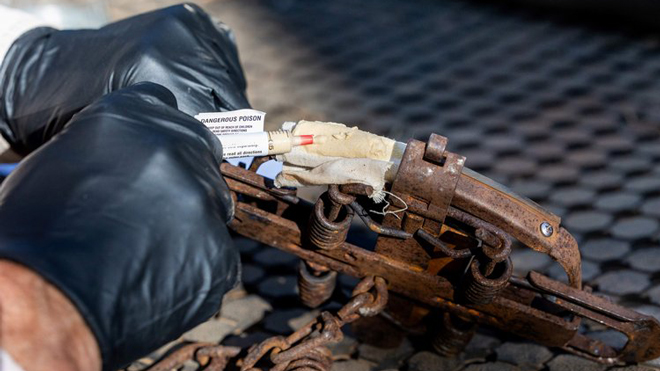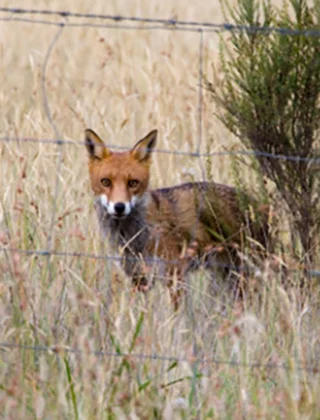PAPPutty lethal paste for wild canids

A new lethal control tool for the management of wild dogs and foxes is now available. The toxin based paste, PAPPutty, is applied to the jaw of a soft-jaw foot-hold trap. When ingested by the trapped predator, they lose consciousness and then die.
The new lethal control tool is a para-aminopropiophenone (PAPP) toxin based paste which is applied to one jaw of a soft-jaw foot-hold trap via cloth wraps. When caught in the trap, wild dogs and foxes tend to bite at the trap and thereby ingest the toxin applied to the cloth.
The dose of PAPP prevents the transport of oxygen in blood, causing the trapped animal to become lethargic before becoming unconscious and quietly dying.
PAPPutty is an alternative to substances which have been applied to foot-hold traps in the past, including strychnine. The current APVMA permit for the use of strychnine impregnated cloths on foot-hold traps will expire on 30 June 2024. After this date the use of strychnine will not be approved.
PAPPutty was developed by the Centre for Invasive Species Solutions (CISS) in collaboration with the NSW Department of Primary Industries (DPI), Connovation in New Zealand, and Animal Control Technologies Australia (ACTA).
Dr Paul Meek and colleagues from NSW DPI conducted large field trials to test PAPPutty. These trials showed that PAPPutty wrapped in cloth attached to the trap jaw resulted in 87% of captured wild dogs accessing the toxin and dying. The average time from trap-to-death was 68 minutes for PAPP-cloths.
Other animals are less susceptible than canids as they metabolise PAPP in a different way, and the delivery of PAPPutty is largely target specific.
A training video of Dr Meek explaining the use and safety precautions for PAPPutty is available on the PestSmart website www.pestsmart.org.au. In the video, he demonstrates how to apply the product to the jaw of a trap using a cloth. PAPPutty can be applied to either the active or lazy jaw of the trap, but not both jaws on the same trap.
As with any form of control, the use of PAPPutty is highly regulated. Similar conditions to other toxin control tools are applicable, including users of PAPPutty must notify neighbours 72 hours before traps are put in the ground and must erect signage to alert visitors that PAPPutty is being used on the property.
A veterinarian-only antidote is available to treat domestic dogs that have accidentally ingested PAPP products, when treated promptly. If you believe your domestic dog has ingested PAPP, seek immediate veterinarian care.
PAPPutty available now
ACTA has been licensed to manufacture and distribute the PAPPutty lethal paste and has formulated the product into 3mL syringes (25 per carton) to allow easy administration to a cloth wrapped around either jaw of a trap (but not both jaws). The registered name for the new product is PAPPutty Lethal Paste for Wild Canids. The product is stable for long periods at room temperature storage.
The most efficient way to purchase the product is to contact your local rural merchant store. For products that contain PAPP (such as PAPPutty), regulations vary between States & Territories. If you are in NSW, contact your regional Local Land Services (LLS). If you are in South Australia, contact your regional Landscape Boards. For all other areas, you should be able to access the product directly from your local rural merchant store.
PAPP is also available in wild dog and fox baits, DOGABAIT and FOXECUTE. These were developed by ACTA and the former Invasive Animals CRC (now Centre for Invasive Animal Solutions) with funding support from AWI and have been available since 2016.
More information:
www.animalcontrol.com.au/products/papputty-lethal-paste-for-wild-canids
Integrated pest management
AWI Vertebrate Pests Program Manager Ian Evans says all available control methods (baiting, trapping, shooting, exclusion fencing, guardian animals) should be considered when planning control activities for wild dogs and foxes.
“The best pest animal control outcomes are usually achieved when an integrated pest management approach is undertaken that combines the use of all suitable control tools,” Ian said.
“The success of wild dog and fox control also relies on a co-ordinated effort of all landholders working cooperatively with private and government controllers. This cooperative approach is important because individual animals move across multiple properties.”
This article appeared in the June 2024 edition of AWI’s Beyond the Bale magazine. Reproduction of the article is encouraged.













